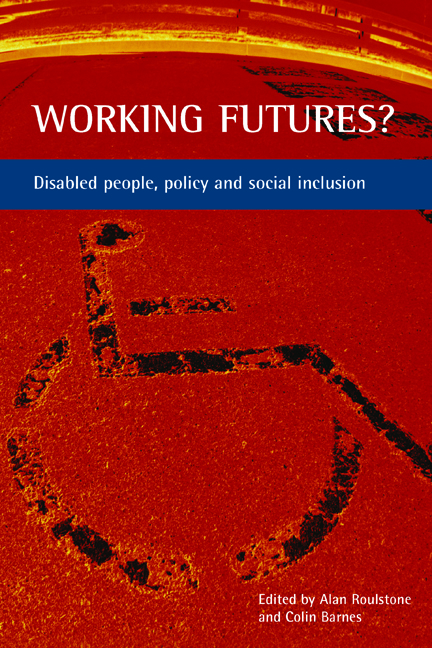Book contents
- Frontmatter
- Contents
- List of figures, tables and boxes
- Preface
- Acknowledgements
- List of abbreviations
- Notes on contributors
- Introduction Working futures: disabled people, employment policy and social inclusion
- Part One Work, welfare and social inclusion: challenges, concepts and questions
- Part Two The current policy environment
- Part Three Towards inclusive policy futures
- Index
- Also available from The Policy Press
thirteen - Employment policy and practice: a perspective from the disabled people’s movement
Published online by Cambridge University Press: 18 January 2022
- Frontmatter
- Contents
- List of figures, tables and boxes
- Preface
- Acknowledgements
- List of abbreviations
- Notes on contributors
- Introduction Working futures: disabled people, employment policy and social inclusion
- Part One Work, welfare and social inclusion: challenges, concepts and questions
- Part Two The current policy environment
- Part Three Towards inclusive policy futures
- Index
- Also available from The Policy Press
Summary
Introduction
This chapter draws on useful insights from organisations of disabled people, their implications for future employment policies and practice. Disabled people have perhaps surprisingly been overlooked in the design, implementation and review of much disability employment policy. I will identify not only evidence of deficits in current policy and practice, but also the roots of these deficits. This chapter will also describe, not only a basis for practical solutions, but also the need for a shift in our understanding of the disability and employment ‘problem’. Put another way, I will ask if social model praxis might be used to carry out a conversion from a deficit approach to disabled people's employment to an investment approach, one which can be translated into new more enabling policies for disabled people.
In applying a ‘deficit approach’, I draw on innovative work that applies for the first time social model ideas to the field of disability and employment in a critical and comprehensive way (Roulstone, 2004). Roulstone's article, presented at one of a series of ESRC seminars organised by the Centre for Disability Studies at the University of Leeds (2003), examines impediments that arise from the view that barriers to disabled people's employment are caused by their personal functional deficits (Martin et al, 1989, p 88). Proposed remedies include user-led research, mainstream living and working, flexible multi-agency support, and the extended use of Direct Payments (including Access to Work funding) in the workplace.
In referring to an ‘investment approach’, I pick up on ideas from a number of developments in social policy, and add a further assertion: those developments crucially depend for their effectiveness on investment in the resource of disabled people's direct experience. I also think there are good ideas to import from policy studies outside employment issues, from current searching reviews on the role of civil society (the voluntary and community sector), and from ‘whole systems’ theory.
Policy directions
In Europe, a ‘movement towards the rights-based equal opportunities approach to disability’ was consolidated as strategy by the mid-1990s (CEC, 1996). The European Union then set a time-frame of six years from November 2000 for measures in member states to ensure that “there shall be no direct or indirect discrimination whatsoever” in employment (European Union, 2000).
- Type
- Chapter
- Information
- Working Futures?Disabled People, Policy and Social Inclusion, pp. 193 - 206Publisher: Bristol University PressPrint publication year: 2005

